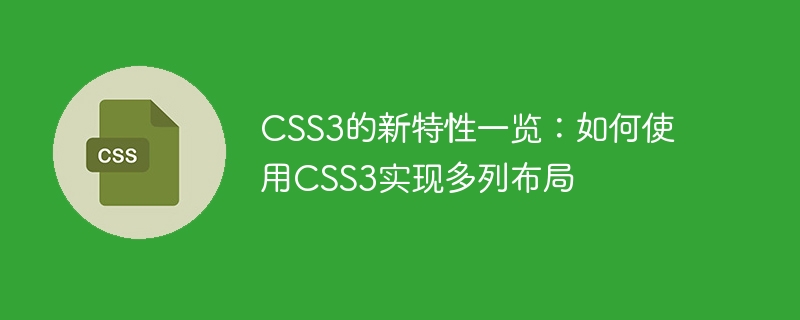

CSS3 is the latest version of the CSS (Cascading Style Sheets) language for web design. Over the past few years, CSS3 has become one of the most commonly used front-end technologies in web design. CSS3 introduces many new features that allow us to control the layout and style of the page more flexibly and precisely. In this article, we will introduce the new features of CSS3 one by one and explore how to use CSS3 to implement multi-column layout.
First of all, let us take a look at the new features of CSS3. CSS3 contains many new modules, some of which have become part of the CSS2 standard, and others are completely new features. The following are some important new features of CSS3:
display: flex attribute, we can easily achieve horizontal and vertical centering, distribution alignment and other layout effects. display: grid property and the grid-template-columns and grid-template-rows properties we can define the columns and rows of the grid and place Content is placed into the grid. Grid layout also provides powerful control over the position and spacing of elements. :hover pseudo-class can be used to select the style when the mouse is hovering over the element, and the ::before pseudo-element can be used to insert content in front of the element. CSS3 introduces a series of new pseudo-classes and pseudo-elements, such as :nth-child pseudo-class and ::placeholder pseudo-element, making selecting and styling elements more flexible and precise. transition and animation to make the implementation of transitions and animations simpler and more intuitive. box-shadow attribute, we can easily add one or more shadow effects to an element. And using the background-image and background-gradient properties, we can create a custom gradient background effect. Now, let’s take a look at how to use CSS3 to implement multi-column layout. In the past, implementing multi-column layouts often required the use of complex JavaScript and HTML structures. However, CSS3 makes implementing multi-column layouts much simpler and more flexible. Here are some ways to implement multi-column layouts using CSS3:
display: flex property and the flex-wrap: wrap property of the parent element, we can divide the child elements into multiple columns according to the specified direction and proportion. column-count and column-gap, which can be used to control the multi-column layout of elements. By setting the column-count attribute and the column-gap attribute of the parent element, we can divide the content into a specified number of columns and control the spacing between columns. To sum up, the new features of CSS3 provide us with more choices and more powerful capabilities to implement multi-column layout. By using flexbox layout, grid layout and multi-column properties, we can easily create flexible and precise multi-column layouts. However, it should be noted that different browsers have different levels of support for CSS3, so you need to consider the compatibility of specific browsers when using new CSS3 features. At the same time, in order to provide the best user experience, CSS3 features should be used rationally to avoid excessive styles and animation effects that cause slow page loading.
The above is the detailed content of Overview of the new features of CSS3: How to use CSS3 to implement multi-column layout. For more information, please follow other related articles on the PHP Chinese website!




